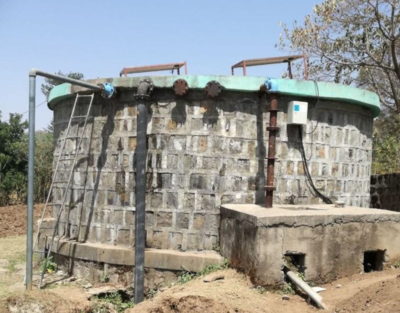Decentralized Drinking Water Supply
Overview
According to the World Health Organization (WHO) statistics, about 7 million people die every year due to contaminated ground water. 1.4 billion people (more than one fifth of the world population) are affected by water shortage and do not have an adequate supply of potable drinking water. People living in remote rural areas or in a suburban housing scheme in developing countries are especially affected by water shortage.[1]
In developing countries a drinking water supply of poor quality is the root of 80% of all illnesses. Through environmental pollution, population growth and an increasing water consumption per person, it is estimated that 50% of the world population will not have enough drinking water by the year 2050. Due to these facts, water purification and an adequate potable water supply are important topics which are discussed world-wide.[2]
In developing countries the situation is intensified due to a poor or non-existent electricity grid. However, developing countries show a prevailingly high potential for the use of renewable energy (e.g. solar, wind). Further, the decentralized electricity supply is often the more cost effective solution as compared to a grid-connected system.[3]
On the large-scale, technologies for desalination and water disinfection are already installed in many different countries and are working reliably. For the application in rural areas of developing countries, however, the need for improvement still exists with regard to the energy supply and minimizing the maintenance requirements.[4]
Technologies - In General
Technologies to produce clean drinking water decentrally, from renewable energy sources and for a reasonable and commercially viable price are at hand. The cost per litre is very much depending on the degree and type of contamination though. Generally it can be said that arsenic contamination is the most expencive to deal with, gladly this type of contamination only occurs in very few countries. Salty/Brackish water is in the middle range when it comes to cost for purification. Sweetwater is the cheapest, as the removal of impurities or bacteria can be done quite easily. At last of course it is cheaper to use a surface water if that is available, as deep well pumps dont have to be run.
If sweet uncontaminated groundwater can be found only very little filtering is needed. Mostly Photovoltaic (PV) Pumping units for this purpose can be built locally and for low costs.
Some suppliers offer high quality combined units for desalination and desinfection that can produce water for 3$-8$ from salt contaminated ground water.
Small, wall-mounted Systems that appear expensive at first can be brought to health centers, schools or even households that have access to a water source. They appear expensive, but run for example from a Solar Home System they can produce enough water to SELL in the neighbourhood for 3$-6$ per 1000L.
Case Studies from EcoPhi (Featured Content)
Remote Monitoring of Water Treatment Systems in Ethiopia
Background:
Pathogens that carry diseases such as cholera can spread through contaminated drinking water and pose a threat to health. In many regions worldwide, water is available, but water sources are polluted, so it is very important to use water treatment systems. For this reason, it is important to monitor water quality.
Using EcoPhi’s Monitoring System to Ensure Good Water Quality:
EcoPhi is monitoring different water treatment systems in Ethiopia. EcoPhi takes care of the remote monitoring of the water treatment plants and provides a central dashboard for all systems and detailed information about each system. The data from the water treatment system is transmitted to the EcoPhi Box via a UART interface. EcoPhi sends this data to the cloud platform, where it is displayed graphically and where users can access and analyse it. The Advanced Box sends the data via the mobile data network. In the event of connection failures or poor connection, the EcoPhi Box stores the data locally and sends it as soon as the connection is re-established. Critical alarms can also be sent directly from the device via SMS. This allows the systems to be monitored even in remote regions.
How the System Helps the People in Ethiopia:
Through the EcoPhi monitoring system, the partners can check at any time whether the systems are working and whether the dosing unit is functioning properly and the chlorine content is correct. A large number of systems can be monitored through the platform. User-specific displays and specific reports allow the team to focus only on the critical facilities. The service enables insight into the system. When comparing multiple systems, weak points can be identified and corrected. Quick failure analyses can be made, allowing technicians to prepare specifically for them, thereby saving travel time. The specified alarms make it possible to intervene quickly in the event of problems with the systems.
Technologies - Without Electricity
Severeal ideas and technologies are available to provide clean drinking water on household level, that do not use any electricity.
To be mentioned:
- The Lifesaver bottle
- The Water cone
- Thermal purification panels
- SODIS
Technical Process
Thermal Purification Processes
Distillation:
- Example for a commercial application: Gerindtec and GIZ in south India
- Thermal desalination: www.solarspring
Electrical Purification Processes
Reverse osmosis:
Further Information
- Solar water purification in Laos
- Wind energy - water desalination
- Solar water purification in India
- Solar water purification
- Overview of solar seawater desalination in the MENA region
References
- ↑ WHO: http://www.who.int/en/
- ↑ Fraunhofer ISE: http://www.ise.fraunhofer.de/en/admin-folder/archiv/areas-of-business-and-market-areas/copy_of_renewable-power-supply/decentralized-%20pv-water-purification-systems
- ↑ Fraunhofer ISE: http://www.ise.fraunhofer.de/en/admin-folder/archiv/areas-of-business-and-market-areas/copy_of_renewable-power-supply/decentralized-%20pv-water-purification-systems
- ↑ Fraunhofer ISE: http://www.ise.fraunhofer.de/en/admin-folder/archiv/areas-of-business-and-market-areas/copy_of_renewable-power-supply/decentralized-%20pv-water-purification-systems





















